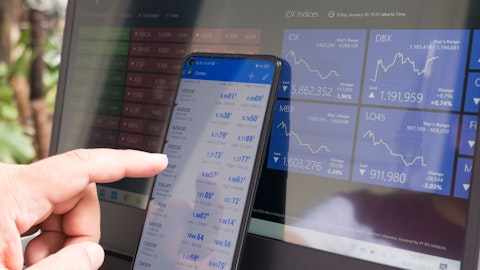William Hamic: Sure. Mike, I would say that we see everything in contracts. There are contracts that don’t tie the index, there are contracts that do. So it’s really hard to draw out a specific, this is what we’re seeing that’s an issue. The biggest issue is that when the contract comes up, are we clear in articulating value? Is that fair proposal because we don’t expect contracts to go our way. We don’t expect them to go to the customer’s way. We expect a middle and fair ground, and part of that is just getting the economics of the contract within range and making sure that the customer expectation for pricing is very similar to what you have, so there are no surprises. So I would say it’s not one tie sets at all. But the really core component of this, and Mark mentioned growing with market is, a very clear local understanding of what’s happening in the box business because unlike linerboard and pulp, the box business is very local, and those decisions have to be very targeted around value propositions and around customer growth in that market.
And I think that’s what’s going to have us turn the corner in a few quarters to get back to growing market. And the last thing I would say is that we’re not seeing customers leave. We’ve certainly picked up some business, but you’re really talking about some marginal volume in local places where maybe the match isn’t perfect long term. Maybe it’s better for both parties to readjust and get to the right value equation.
Michael Roxland: Got it. And just, I guess, one quick follow-up in terms of your strategy on GCF and really trying to enhance the mix. Do you see — in terms of the portfolio itself, obviously, post-Riegelwood, post-Pensacola, are there other opportunities for you to rightsize your portfolio there? If — basically, if demand is not materializing as you would expect?
Clay Ellis: Yes, Mike, this is Clay Ellis. Yes, I think as you mentioned, the mitigating the exposure that we have to commodity or paper-grade pulp at the Riegelwood mill. If you look at 2024, post the closure of Riegelwood 20, we still have some exposure. We’re not at our optimized mix, although we’re much further along the way toward that. But we believe fluff will grow, and that will — obviously, we’ll move SBSK or paper grade to fluff. So we think exiting ’24 and to ’25, we’ll be getting pretty close to our optimized mix. There will always be a small amount of the paper-grade pulp in the mix. And we — but we think we’ll be getting to really our optimized mix here exiting ’24 and to ’25. So we’ll have an improvement through, all through ’24.
Of course, we have levers if fluff pulp did not grow and such, there are things that we have as options. But that’s not really what we believe or what — we think absorbent hygiene products will grow. And therefore, we think that fluff will grow. We’re excited about the trend.
Operator: Your next question comes from the line of Mark Weintraub from Seaport Research Partners.
Mark Weintraub: Maybe first of all, I’m going to follow up on Phil’s question, and I realize you may or may not say anything on this, but it’s probably the question investors are thinking about most. So I’ll give it a shot. And that is understanding there’s a lot of variability on how pricing can play out, and that can have a very large impact on where numbers ultimately end up in ’24. You did provide us with an assessment on your volume. You’ve talked about a lot of the different internal initiatives, et cetera. Is it possible that, as you did last year, you could give us a range if we exclude impact from any price changes not yet reflected in the trade publications?
Timothy Nicholls: Mark, it’s Tim. We could — I mean we can look at that, but we did think about it carefully entering to this call. And just given the size and the fluidity and all of those factors, we just chose not to do it at this moment. So like I said a minute ago, we can look at it quarter-by-quarter and see if it makes sense. But for this quarter, we chose not to.
Mark Weintraub: Okay. Fair enough. And then just maybe on this — the shipping businesses getting paid for value, a process you’ve been doing for a long time. Where are you would you say with your customers? Is the vast majority now where you think it should be? How much more of these negotiations is there yet to go? And just for context, if we go back several years, there’s been a relatively continual decline in your market share on the box volume business. So what’s — is there anything added you can provide to us to feel like, okay, yes, we do have visibility on when this can turn the corner?
William Hamic: Sure I would portray it as we’re pretty confident that we’re going to come back to market. And I think there are 2 things driving that. One is we’ve got a strategic view of the customer base. We understand who’s growing, who’s not growing. We understand the value equation. I think, much better than we have in the past. We’ve worked very hard in understanding that. But I think the key is investing behind the growth. So as we change the portfolio, we’re investing very quickly in a targeted way. And so I think that positions us probably better than in the past in terms of having the right capacity and the right markets to grow with the customers. And so if you want to look back and say, how could we have approved, is there’s not a national strategy as much as there’s a national and a local strategy for investment, and I think that positions us well to grow.





